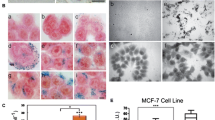Abstract
MCF-7 human breast cancer cells sensitive and resistant to cisplatin and doxorubicin were used in experiments. Various cultivation times of these cells in the presence of iron nanoparticles were used for the study. The potentialities of light optical visualization and also the peculiarities of the distribution, localization, and the dynamics of the accumulation of the liposomal form of ferromagnetic in cells have been studied. Based on an analysis of the data obtained in the experiments, we supposed that the most possible route for the inflow of iron nanoparticles into the examined cells is receptor mediated endocytosis, because after a 24-h incubation period, the incorporated iron is in the shape of separated granules localized near the cytoplasmic membrane. In addition, after 24 and 48 hours of cultivation, we discovered an increase in the number of ironpositive cells, as well as an increase in the percentage of tumor cells with a high ferromagnetic content due to the formation of dense structures characterized by cytoplasmic and perinuclear localization. It has been proved that the dynamics of the ferromagnetic accumulation and release from the cells are connected with their resistance to antitumor drugs and with their cultivation time in the presence of iron nanoparticles.
Similar content being viewed by others
References
Mal’tsev, P.P., Nanotekhnologii. Nanomaterialy. Nanosistemnaya tekhnika (Nanotechnology. Nanomaterials. Nanosystem Technology), Moscow: Tekhnosfera, 2008.
Chekhun, V.F., Nanotechnology in Cancer: Prospects for Development and Unforeseen Difficulties, Lancet Oncology Ukrainian edition, 2010, vol. 4, no. 14, pp. 2–3.
Chekhun, V.F., The Role of Innovative Technologies in Solving Oncological Problems, Visn. NAN Ukr., 2008, vol. 9, pp. 38–42.
Nie, S., Xing, Y., Kim, G.J., and Simons, J.W., Nanotechnology Applications in Cancer, Annu. Rev. Biomed. Eng., 2007, 9, pp. 257–288.
Golovenko, M.Ya., Nanomedicine: Achievements and Prospects of Development of New Technologies in Diagnosis and Treatment (Review), Zh. Akad. Med. Nauk Ukr., 2007, vol. 13, no. 4, pp. 617–635.
Baum, C., Hegewiseh-Becker, S., Sckert, N.G., et al., Novel Retroviral Vectors for Efficient Expression of the Multidrug Resistance (mdr-1) Gene in Early Hematopoetic Cells, J. Virol., 1995, vol. 69, no. 6, pp. 7541–7547.
MacKenzie, E.L., Iwazaki, K., and Tsuji, Y., Intracellular Mechanisms to Health Implications, Antioxid. Redox. Signal., 2008, vol. 10, no. 6, pp. 997–1030.
Movchan, B.A., Electron Beam Nanotechnology and New Materials in Medicine — First Steps, Visn. Farmakol. Farmats., 2007, vol. 12, no. 5, pp. 5–13.
Mikhailov, G.A. and Vasil’eva, O.S., Future Technology: the Use of Magnetic Nanoparticles in Oncology, Byul. SO RAMN, 2008, vol. 131, no. 3, pp. 18–22.
Gubin, S.P., Koksharov, Yu.A., Khomutov, G.B., et al., Magnetic Nanoparticles: Methods of Obtaining, Structure, and Properties, Usp. Khim., 2005, vol. 74, no. 4, pp. 539–574.
Naleskina, L.A., Borodai, N.V., and Chekhun, V.F., Present and Prospects of Designing Nanosystems for Targeted Drug Delivery to Tumor Cells, Onkologiya, 2009, vol. 11, no. 3 (41), pp. 166–173.
Lammers, T., Hennink, W.E., and Storm, G., Tumour-Targeted Nanomedicines; Principles and Practice, Brit. J. Cancer, 2008, vol. 99, no. 3, pp. 392–397.
Kumar, A., Jena, P.K., Behera, S., et al., Multifunctional Magnetic Nanoparticles for Targeted Delivery, Nanomed. Nanotechn. Biol. Med., 2010, vol. 6, pp. 64–69.
Pal’tsev, M.A., Severin, E.S., and Ivanov, A.A., Pathological Anatomy and Molecular Diagnostics, Arkh. Patol., 2006, vol. 68, no. 4, pp. 3–7.
Chekhun, V.F., Khaetsmkii, I.K., Kurapov, Yu.A., Didikin, G.G., Litvin, B.O., and Paton, B., UA Patent No. 47930, Bull. No. 4, 2009.
Lilli, R., Patogistologicheskaya tekhnika i prakticheskaya gistokhimiya (Histopathological Technique and Practical Histochemistry), Moscow: Mir, 1969.
Nalskina, L.A, Luk’yanova, N.Yu., Demash, D.V., Kuns’ka, L.M., and Chekhun, V.F., UA Patent No. 10785/1, 2010.
Schulze, E., Ferrucci, J.T., Poss, K., et al., Cellular Uptake and Trafficking of a Prototypical Magnetic Iron Oxide Label in vitro, Invest. Radiol., 1995, vol. 30, no. 10, pp. 604–610.
Moore, A., Weissleder, R., and Bogdanov, A., Uptake of Dextran-Coated Monocrystalline Iron Oxides in Tumor Cells and Macrophages, J. Magn. Reson. Imaging, 1997, vol. 7, no. 6, pp. 1140–1145.
Raynal, I., Prigent, P., Peyramaure, S., et al., Macrophage Endocytosis of Superparamagnetic Iron Oxide Nanoparticles: Mechanisms and Comparison of Ferumoxides and Ferumoxtran-10, Invest. Radiol., 2004, vol. 39, no. 1, pp. 53–56.
Author information
Authors and Affiliations
Corresponding author
Additional information
Original Ukrainian Text © L.A. Naleskina, N.Yu. Lukyanova, L.M. Kunskaya, D.V. Demash, V.F. Chekhun, 2011, published in Tsitologiya i Genetika, 2011, Vol. 45, No. 6, pp. 61–66.
About this article
Cite this article
Naleskina, L.A., Lukyanova, N.Y., Kunskaya, L.M. et al. Visualization of the features of the distribution and accumulation of iron nanoparticles in human breast cancer cells sensitive and resistant to antitumor drugs after cultivation with liposomal ferromagnetic during various time intervals. Cytol. Genet. 45, 395–399 (2011). https://doi.org/10.3103/S0095452711060077
Received:
Published:
Issue Date:
DOI: https://doi.org/10.3103/S0095452711060077




